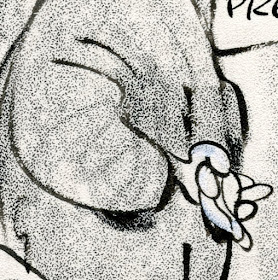The year 2018 gave us important discoveries about the origins of art.
Archaeologists have known for some time that our ancestors developed crude weapons (hammerstones and cutting tools)
as far back as 2.6 million years ago. After achieving that milestone, it took almost another million years for us to develop more sophisticated weapons, such as stone axes. Those
date back 1.76 million years. We continued to develop and refine our arsenal, so that 1.3 million years later, in 400,000 BCE, we had invented
throwing spears with sharp points.
In September of this year, archaeologists announced that they had discovered
the earliest known drawings by homo sapiens: a 73,000 year old cross hatched pattern found in a cave in Africa.
As reported in the journal
Nature, researchers used both microscopic and chemical analysis to establish that the marks were intentionally made by a human hand using a pointed crayon fashioned from red ocher clay.
In other words, as far as we know 2,527,000 years elapsed between the first weapon and the first art.
In spite of all the ingenuity, effort and trial that went into the development of weapons, we were still 2.5 million years away from the urge to make abstract designs on a surface.
Not only that, but November 2018 also brought news of the discovery of the first known figurative drawing by a human, dating back 40,000 years:
The drawing was discovered in a limestone cave in East Kalimantan, Indonesian Borneo. Its age was confirmed by chemical analyses of natural deposits that had formed on top of the drawing.
So as far as we know it took us 33,000 years to progress from cross hatching to figurative drawing. That's four times longer than the time from the founding of the ancient Egyptian Empire until today.
Why did it take so much longer for art to arrive on the scene than weapons? Was the urge to make designs really millions of years harder than the urge to kill? And did it really require another 40,000 years to go from making abstract designs to making marks that resemble something in the world?
Your guess is as good as mine, but perhaps it took that long before our ancestors felt the need for a more subtle and profound vocabulary, the kind used for communicating more advanced concepts such as love and pain, hope and beauty. When our emotional range was limited to fear and hunger we may have had no need for the language of art. But when we finally had a more complex range of feelings and more complicated emotions to communicate, I'm guessing a hammerstone just wouldn't do.
It might've taken 2,527,000 additional years for us to experience subtler shades of meaning and then develop a voice capable of shaping and expressing them.
Whatever the reason, as you start out to make art in 2019, reflect on why it took our ancestors an additional 2.53 million years to invent art, and try to make something worthy of that long incubation.
Happy new year to all!








.jpg)












